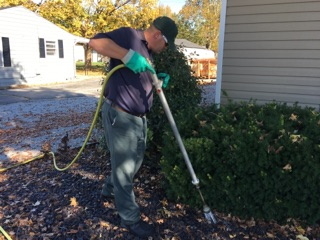Fall Fertilization
Grub damage is by far the most common type of damage sustained in turf grasses throughout the United States. Customers who choose to add grub control to their scheduled services will receive it along with control of all turf feeding and subsurface feeding insects. White grubs and many other subsurface feeding insects usually go unnoticed until the results of their feeding on the root system in your lawn are observed in late August and into early fall.
An active population can easily destroy your lawn in a very short period of time. In addition to these subsurface feeding insects causing damage themselves, their presence tends to attract animals, such as birds, mice, rats, gophers, groundhogs, raccoons and skunks, who love to feed on an active grub population; ultimately, causing even further damage to your lawn.

Our GatorGuarantee for all customers: If you're not satisfied with our service, we'll return to your property, free of charge. And if you're still not happy, we'll refund your last application and pay you $25 for your trouble!
Let's Get Started
There are no obligations and estimates are always FREE. To get started we will need some basic address and contact information and then we can provide you with pricing.
Additional Recommended Services
Our lawn care programs include scheduled applications of fertilizer and weed control. These treatments create a healthier, lush, and green lawn. A great-looking lawn results from consistent and proper care. Successful lawn care requires technical knowledge and turf management experience.
Turf grasses in our area benefit from annual lawn aeration. Aeration reduces thatch buildup and relieves soil compaction. This service improves the flow of air, water, and nutrients. Improved flow helps nutrients reach the root system more effectively.
A soil analysis determines pH level, available nutrients, and organic matter percentage. It helps identify problems like poor turf color or bare spots. Use it to diagnose low seed germination and recurring disease issues. Soil testing is a key tool for effective lawn care decisions.
Fall Fertilization FAQ's
During the growing season, landscape ornamental trees and shrubs are both growing above and below the ground. Providing nutrients at this time will typically be used up by excessive unhealthy foliage growth; if done late during the growing season, this may not allow enough time to harden off before the winter season. This service targets the development of the root system, therefore must be done after the growing season and just prior to the winter season. The products we use are scientifically proven formulations of quality nutrients that provide root development and maximum efficiency of foliage development the following spring.
No, both newly planted and mature landscape ornamental trees and shrubs will benefit from the controlled release nitrogen in Fall Fertilization.
The purpose of this application is to provide nutrients to the root system for both growth and health of the overall tree or plant. Spraying the product directly on the branches will not trans-locate to the root zone. Drenching the soil around the drip line ensures that the fertilizer will be absorbed by the root system.
Fertilizing trees and shrubs in the fall helps them with the essential nutrients before winter dormancy. This aids in root development and strengthens the plants for the upcoming growing season. Additionally, during the fall, plants allocate energy towards root growth, making it an optimal time for nutrient absorption from fertilizers.
While active growth slows down during dormancy, nutrients are still important for trees and shrubs during this period. Nutrients stored in the roots and other plant tissues play a crucial role in supporting various biological processes that continue even when the plant is dormant. These nutrients help the plant maintain its overall health and prepare for the upcoming growing season. Providing proper nutrients before dormancy can help ensure that the plant has the resources it needs to thrive when it needs to resume active growth in the spring.
